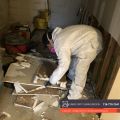Everything You Need to Know About Mold: Types, Prevention, Testing, and Remediation

Introduction
Mold is a common yet often misunderstood problem that affects both homes and businesses. Left untreated, mold can cause health issues, structural damage, and recurring problems. Understanding the different types of mold, how to stop its growth, and what to expect during testing and remediation is essential for effectively dealing with it.
At Bay Area Mold Pros, we specialize in mold inspection and mold testing oversight to ensure your property is safe and healthy. Call (650) 762-6228 today to schedule a professional mold inspection or testing service with certified mold inspector Rick Bruce.
Mold Types Explained
Mold comes in many forms, and not all are created equal. The most common types found in homes and businesses include:
1. Black Mold (Stachybotrys chartarum)
- Appearance: Dark green or black, slimy texture.
- Risks: Produces toxic mycotoxins that can cause severe respiratory and neurological issues.
- Common Locations: Areas with persistent moisture, such as leaky basements or water-damaged walls.
2. Green Mold (Aspergillus, Cladosporium)
- Appearance: Green or bluish-green, fuzzy texture.
- Risks: Triggers allergies and asthma; some types produce harmful mycotoxins.
- Common Locations: Bathrooms, kitchens, and damp areas.
3. White Mold (Penicillium)
- Appearance: White or gray, powdery texture.
- Risks: Causes respiratory irritation and allergies.
- Common Locations: Attics, crawl spaces, and wood.
4. Yellow Mold (Serpula lacrymans)
- Appearance: Yellow or gold, often called "house-eating mold."
- Risks: Damages wood and building materials.
- Common Locations: Under carpets, subflooring, and damp walls.
Each type of mold requires a targeted approach for removal and prevention, making professional mold inspection and testing critical.
Dealing With Mold: What You Need to Know
When mold is discovered, it’s essential to act quickly to prevent its spread and minimize health risks. Here are the key steps to take:
1. Identify the Source
Mold thrives in damp environments, so locating and fixing water leaks, condensation, or high humidity is crucial.
2. Don’t Disturb Mold
Avoid scrubbing or disturbing visible mold, as this can release spores into the air, worsening the problem.
3. Contact Professionals
Hiring a certified mold inspector ensures accurate identification of mold type, extent, and the source of the problem.
How to Stop Mold Growth
Prevention is key when it comes to mold. Follow these steps to keep mold at bay:
1. Control Moisture
- Keep indoor humidity levels below 50%.
- Fix leaks and address water damage promptly.
- Use dehumidifiers in damp areas like basements or crawl spaces.
2. Ensure Proper Ventilation
- Install exhaust fans in bathrooms, kitchens, and laundry rooms.
- Open windows or use air purifiers to promote airflow.
3. Clean Regularly
- Clean and dry areas prone to moisture, such as showers and sinks.
- Use mold-resistant products, such as paint and caulk, in vulnerable areas.
4. Inspect Periodically
Regular inspections, especially after water damage or leaks, help catch mold growth early.
Understanding Mold Testing and Mold Inspection
Mold testing and inspection are vital for identifying mold problems and planning effective remediation.
What Happens During a Mold Inspection?
- Visual Assessment: Inspectors look for visible signs of mold, water damage, and moisture issues.
- Moisture Detection: Tools like moisture meters and thermal imaging identify hidden damp areas.
- Air and Surface Testing: Samples are collected to identify mold types and spore concentrations.
Why Mold Testing Matters
- Confirms the presence and type of mold.
- Assesses the severity of contamination.
- Helps determine the best remediation approach.
Certified mold inspector Rick Bruce at Bay Area Mold Pros provides comprehensive mold inspections and testing to ensure nothing is overlooked.
What to Expect During Mold Remediation
Mold remediation is a multi-step process designed to safely remove mold and prevent its return:
1. Containment
The affected area is sealed off to prevent spores from spreading.
2. Air Filtration
HEPA filters and negative air machines are used to capture airborne spores during the remediation process.
3. Mold Removal
Moldy materials, such as drywall or insulation, are safely removed and discarded. Surfaces are cleaned and treated with antimicrobial agents.
4. Repairs
Damaged areas are repaired or replaced to restore your property.
5. Moisture Control
The underlying moisture issue is addressed to prevent future growth.
The Importance of PRV (Post-Remediation Verification) Mold Inspections and Testing
After remediation, PRV inspections and testing ensure the mold issue has been fully resolved.
What Is PRV Testing?
Post-remediation verification involves:
- Visual Inspection: Confirming no visible mold or damage remains.
- Air and Surface Testing: Ensuring spore levels are normal and no hidden mold persists.
Why PRV Is Critical
- Confirms the success of remediation efforts.
- Provides peace of mind that your property is safe and mold-free.
- Helps maintain property value and avoids future complications.
At Bay Area Mold Pros, we provide thorough PRV inspections to guarantee your property is mold-free and safe for occupancy.
Why Choose Bay Area Mold Pros?
With years of experience serving the San Francisco Bay Area, Bay Area Mold Pros is your trusted partner for mold inspection and mold testing oversight.
- Certified Expertise: Rick Bruce is a certified mold inspector with a proven track record.
- Comprehensive Services: From initial inspection to PRV testing, we cover every step of the process.
- Advanced Tools: Our team uses state-of-the-art equipment to detect and address mold effectively.
- Customer-First Approach: We prioritize your safety and satisfaction with tailored solutions.
Conclusion
Mold problems require a proactive approach to protect your health and property. From understanding mold types to preventing growth and navigating remediation, working with certified professionals like Bay Area Mold Pros ensures you’re in safe hands.
Don’t wait—call (650) 762-6228 or visit bayareamoldpros.com today to address your mold concerns.





